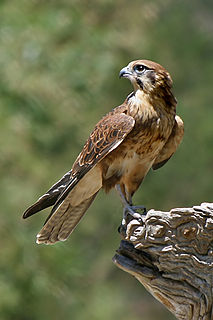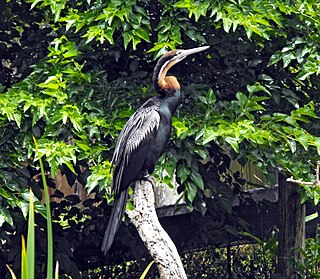
Penguins are a group of aquatic flightless birds. They live almost exclusively in the southern hemisphere: only one species, the Galápagos penguin, is found north of the Equator. Highly adapted for life in the water, penguins have countershaded dark and white plumage and flippers for swimming. Most penguins feed on krill, fish, squid and other forms of sea life which they catch while swimming underwater. They spend roughly half of their lives on land and the other half in the sea.

Falcons are birds of prey in the genus Falco, which includes about 40 species. Falcons are widely distributed on all continents of the world except Antarctica, though closely related raptors did occur there in the Eocene.

The darters, anhingas, or snakebirds are mainly tropical waterbirds in the family Anhingidae, which contains a single genus, Anhinga. There are four living species, three of which are very common and widespread while the fourth is rarer and classified as near-threatened by the IUCN. The term snakebird is usually used without any additions to signify whichever of the completely allopatric species occurs in any one region. It refers to their long thin neck, which has a snake-like appearance when they swim with their bodies submerged, or when mated pairs twist it during their bonding displays. "Darter" is used with a geographical term when referring to particular species. It alludes to their manner of procuring food, as they impale fishes with their thin, pointed beak. The American darter is more commonly known as the anhinga. It is sometimes called "water turkey" in the southern United States; though the anhinga is quite unrelated to the wild turkey, they are both large, blackish birds with long tails that are sometimes hunted for food.

The Anatidae are the biological family of water birds that includes ducks, geese, and swans. The family has a cosmopolitan distribution, occurring on all the world's continents except Antarctica. These birds are adapted for swimming, floating on the water surface, and in some cases diving in at least shallow water. The family contains around 174 species in 43 genera.

Phalacrocoracidae is a family of approximately 40 species of aquatic birds commonly known as cormorants and shags. Several different classifications of the family have been proposed and the number of genera is disputed, but in 2021 the IOC adopted a consensus taxonomy of 7 genera. The great cormorant and the common shag are the only two species of the family commonly encountered on the British Isles and "cormorant" and "shag" appellations have been later assigned to different species in the family somewhat haphazardly.

Rheidae is a family of flightless ratite birds which first appeared in the Paleocene. It is today represented by the sole living genus Rhea, but also contains several extinct genera.

Anas is a genus of dabbling ducks. It includes the pintails, most teals, and the mallard and its close relatives. It formerly included additional species but following the publication of a molecular phylogenetic study in 2009 the genus was split into four separate genera. The genus now contains 31 living species. The name Anas is the Latin for "duck".

Struthio is a genus of birds in the order Struthioniformes, whose members are the ostriches. It is part of the infra-class Palaeognathae, a diverse group of flightless birds also known as ratites that includes the emus, rheas, and kiwis. There are two living species of ostrich, the common ostrich and the Somali ostrich. They are large flightless birds of Africa who lay the largest eggs of any living land animal. With the ability to run at 70 km/h (43.5 mph), they are the fastest birds on land. It is farmed worldwide, particularly for its feathers as they are used as decoration and feather dusters. Its skin is also used for leather products.

Phorusrhacids, colloquially known as terror birds, are an extinct clade of large carnivorous flightless birds that were the largest species of apex predators in South America during the Cenozoic era; their conventionally accepted temporal range covers from 62 to 1.8 million years (Ma) ago.

Leptoptilos is a genus of very large tropical storks, also known as the adjutant bird. The name means thin (lepto) feather (ptilos). Two species are resident breeders in southern Asia, and the marabou stork is found in Sub-Saharan Africa.

Mesembriornis is a genus of intermediate-sized phorusrhacids that grew up to 1.5 metres (4.9 ft) in height. They represent a well-distinct lineage of terror birds, differing from the massive large groups and the smaller Psilopterinae. In general proportions, they most resembled the Patagornithinae which flourished somewhat earlier, mainly to the south of the range of Mesembriornis. Fossils of the terror bird have been found in Montehermosan deposits of the Monte Hermoso Formation in Argentina.

Eudromia is a genus of birds in the tinamou family. This genus comprises two crested members of this South American family.
Aratinga vorohuensis is a prehistoric relative of the nanday parakeet described from Late Pliocene fossils found in and named after the Vorohué Formation of Buenos Aires Province, Argentina.
Heterorhea is an extinct genus of ratites in the rhea family. The type species is H. dabbenei. from the Late Pliocene Monte Hermoso Formation, Buenos Aires, Argentina. The holotype of the genus is missing.
Devincenzia is an extinct genus of giant flightless predatory birds in the family Phorusrhacidae or "terror birds" that lived during the Early Miocene (Deseadan) Fray Bentos Formation of Uruguay and Late Miocene (Huayquerian) Ituzaingó Formation to Early Pliocene (Montehermosan) of Argentina. The type species D. pozzi was formerly known as Onactornis pozzi. A second species D. gallinali has been described. It stood about 2.5 metres (8.2 ft) tall.

Skeletal pneumaticity is the presence of air spaces within bones. It is generally produced during development by excavation of bone by pneumatic diverticula from an air-filled space, such as the lungs or nasal cavity. Pneumatization is highly variable between individuals, and bones not normally pneumatized can become pneumatized in pathological development.

Llallawavis scagliai is a large, extinct predatory bird from Pliocene Argentina. Its fossil is the most complete fossil of a phorusrhacid yet found.
Uquiasaurus is an extinct genus of iguanian lizards represented by the type species Uquiasaurus heptanodonta from the Late Pliocene of Argentina. Uquiasaurus was first described in 2012 on the basis of isolated snout and jaw bones within the Uquía Formation, the namesake of the genus. These bones were preserved in a midden of predatory bird pellets and are part of a microvertebrate assemblage that includes the bones of rodents, marsupials, frogs, birds, and other lizards, one of the few to document the mixing of North and South American faunas during the Great American Interchange. Phylogenetic analysis indicates that Uquiasaurus is part of a clade of iguanians that includes the living families Liolaemidae, Leiocephalidae, and Tropiduridae. Below is a cladogram from Daza et al. (2012) showing its phylogenetic relationships:















